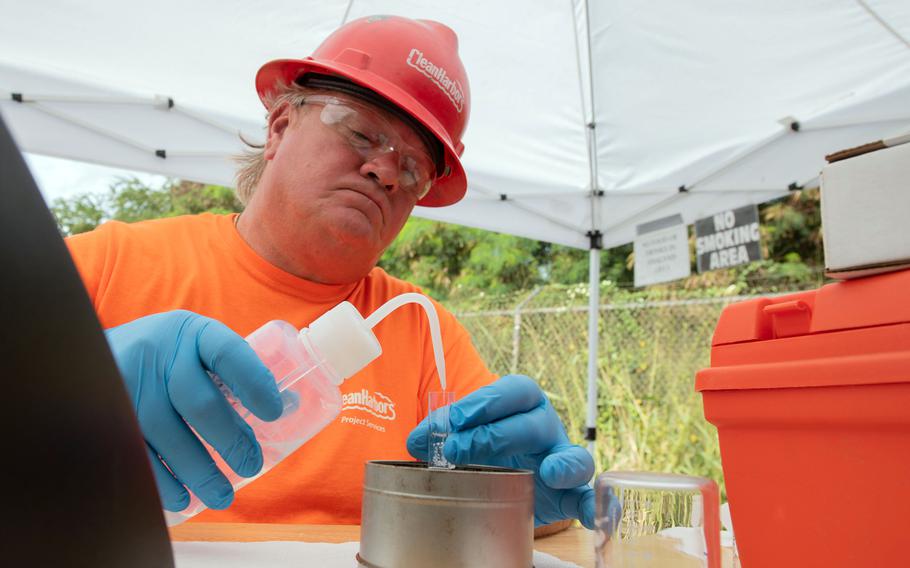
A Navy contractor tests a Red Hill well water sample for total petroleum hydrocarbons, or TPH, March 8, 2022. (Christopher Thomas/U.S. Navy)
FORT SHAFTER, Hawaii — The Hawaii Department of Health has directed the Navy to test one of its wells near Joint Base Pearl Harbor-Hickam after learning of another spate of complaints about tap water quality.
A member of the Red Hill Community Representative Initiative informed Health Department officials on Thursday that about 50 users of the Navy’s water distribution system had complained about the water, the department said in a news release Monday.
A handful of residents complained of similar problems in October.
“DOH is taking these reports seriously and as the state regulator for Hawaiʻi’s water purveyors, the department continues to conduct oversight of the Navy’s water distribution system,” the release said.
The Navy’s water distribution system for the joint base and surrounding military communities was contaminated in late 2021 by a jet fuel spill from the Red Hill Bulk Fuel Storage Facility on the outskirts of Honolulu a few miles from the base.
The leak contaminated one of three wells used by the Navy for its water distribution system, one of which remains contaminated but isolated from the system.
Defense Secretary Lloyd Austin in March 2022 ordered the facility permanently closed, and the Defense Department is in the process of emptying the roughly 40,000 gallons of fuel left in the tanks.
The 10-member Community Representative Initiative was established in September to liaison directly with the Navy, U.S. Environmental Protection Agency and Defense Logistics Agency in regard to water safety issues arising from the Red Hill facility.
Lacey Quintero, a member of the initiative, said by phone Tuesday that the new complaints are both about how water looks and smells, as well as health issues stemming from the water. Some samples have a sheen, while others exude a visible vapor, she said.
Complaints are widespread and not confined to a single neighborhood, she said.
The Health Department on Monday directed the Navy to test its Waiawa well shaft. Petroleum was not detected in samples taken from that well in October, the Health Department said in the release.
In addition, Health Department officials have requested contact information for each of the complainants so that on-site inspections and sampling can be conducted, the news release states.
Navy Region Hawaii instructed residents how to report problems with tap water in a Monday news release.
“Water concerns can be reported, and in-home testing can be requested, without fear of reprisal,” the release states. “The Navy will provide bottled water to residents until validated test results from the [U.S. Environmental Protection Agency]-certified laboratory confirm that the water meets Federal and State safe drinking water standards.”
The Waiawa shaft, more than six miles from the Red Hill fuel facility, has been the Navy’s sole source for its system since December 2021, the Navy news release states.
Last fall, the EPA tested water samples from a handful of homes after residents there complained of seeing a sheen on the water and experiencing skin rashes.
“Sampling results appeared to demonstrate the potential trace presence of petroleum hydrocarbons as diesel in three of the four homes,” concluded an EPA report issued in December.
The Navy tested more samples from those homes in December for the presence of total petroleum hydrocarbons, or TPH, which includes hundreds of compounds found in petroleum-based products, Navy Region Hawaii said in a Jan. 8 news release.
No signs of JP-5 jet fuel, the type that contaminated the Red Hill well, were found in those samples, the news release said.
Some samples indicated the presence of TPH, but those levels were all below the threshold at which the Hawaii Department of Health deems water to be unsafe for drinking, which is above 266 parts per billion.
Quintero, as well as others affected by the fuel spill, consider that cutoff to be arbitrary and that lower levels of TPH could be affecting the health of residents on the Navy water system.